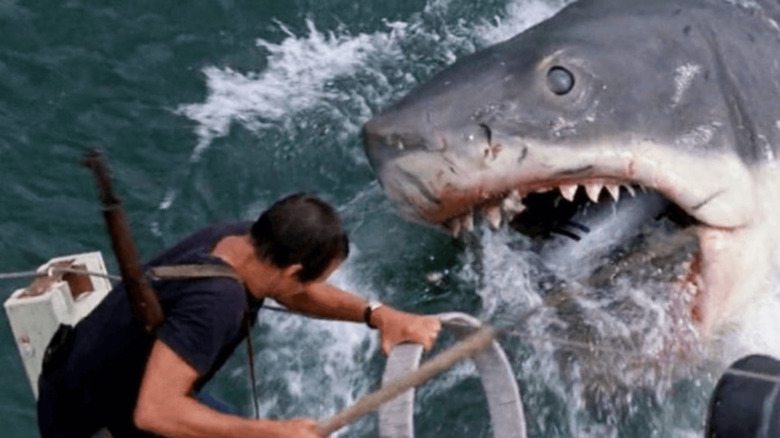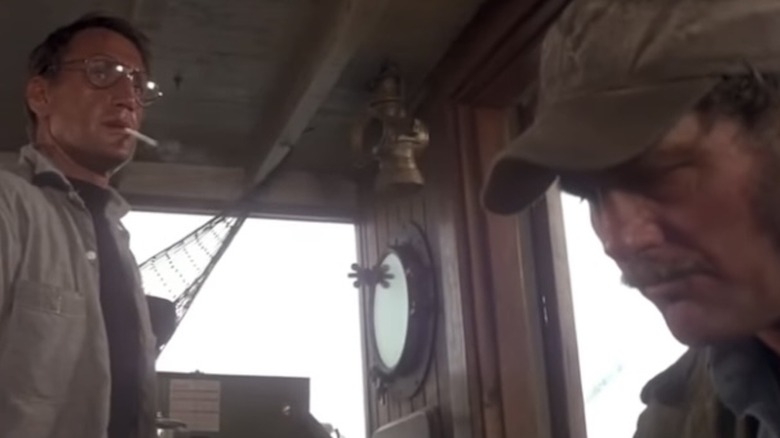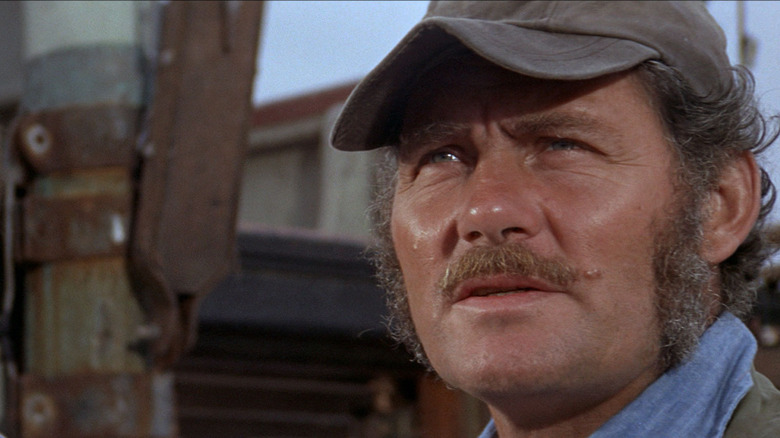The Stubbornness Of Steven Spielberg Made Jaws' Production A Hollywood First
Few American thrillers rival the creeping tension of "Jaws," Steven Spielberg's terrifying tale of a gargantuan shark stalking an island town. In just two notes, composer John Williams concocted the soundtrack for a beast that would haunt beaches and our imaginations for decades. It's almost impossible to fathom that a movie so iconic emerged from the depths of a nightmarish production.
For his adaptation of Peter Benchley's 1974 bestselling novel of the same name, Spielberg didn't just want to evoke the eerie isolation of vast, open waters — he wanted to film there. In a video commentary on the making of "Jaws," the director said he balked at the suggestion that the crew film in a tank on a Hollywood backlot or on a placid lake.
"I was the only person who basically insisted that we shoot it in the Atlantic Ocean. I mean, it was insane ... The lake water, pond water, tank water, doesn't have the same texture or even violence that the ocean has. And this needed to be a convincing story about a great white shark, because if it wasn't, nobody would really believe it."
'We're gonna need a bigger flotilla'
Before Jaws, no film company had shot a feature of that size on the open water, according to filmmaker J. Michael Roddy. After watching several sea movies shot on a lot, Spielberg and his production designer Joe Alves concluded that the scenes looked fake. The 26-year-old director laid out grand plans: they would shoot a 25-foot shark in the middle of the Atlantic ocean.
Universal had already purchased rights to the novel in 1973 and that summer, Alves began scouting for locations in New England. He settled on Martha's Vineyard, a picturesque island better known as a summer home for Kennedys than man-eaters.
The reality of shooting under the mercurial conditions of New England weather soon sunk in for Spielberg and his crew. Currents would shift and dark clouds ruined what should have been scenes of sunny Amity Island beaches. Spielberg brought a massive crew to the island, who all needed a floating base of their own during the open water shots. What sprang up was a makeshift navy that could support "Jaws," with 65 people sleeping and working on the electrical barge alone, the Vineyard Gazette wrote:
"The shooting flotilla consisted of about 16 boats. The tugboat White-foot under Capt. Roy W. Campbell served as mother ship, restaurant, base and towboat. A strange roofed raft with the stranger name, S. S. Garage Sale, housed dressing rooms, compressors, diving gear, a head, lumber, tools, controls for the going-up shark and a special box for working its jaws. The old City of Chappaquiddick was used as the electrical barge and carried lights, camera and action. She was a jumble of equipment, clothing, lenses, mammoth arc lights, cables and potato chips."
'I shall not return!'
The production had chosen the Vineyard because even when they ventured 12 miles out in the open water, its depth only measured 30 feet. That turned out to be a blessing when the often malfunctioning mechanical shark, nicknamed "Bruce," sank to the bottom of the ocean during filming. The production's vain attempts to waterproof their robots failed and the crew had to install pneumatic pumps on three sharks so they could operate in salt water. Bruce broke down so frequently during production that Spielberg's initial plans to feature the shark more prominently were scrapped. In lieu of closeups, they conjured the specter of the shark using John Williams' foreboding score, giving the film a more Hitchcockian flair.
In filming "Jaws" on the sea, Spielberg set up his own "man versus nature" conflict. At every turn, the salty waters and tempestuous winds off the Vineyard's coast damaged his man-made sharks and chilled his actors. By the time the director wrapped his last shot on the island in October 1974, he waved to his crew from a departing boat "I shall not return!"
Despite the hurdles of filming on the ocean, Spielberg's stubborn decision is what gives the movie its haunting quality. At least a quarter of the film is shot at the water line to give viewers a sense of treading water. The insistence on practical effects like those, shot in the Vineyard, lend both a sense of place and dread to "Jaws." Like his heroes in the film, Spielberg set out on an ocean adventure he was unprepared to handle. Fortunately, the fate of his production and his film fared better than his characters.


